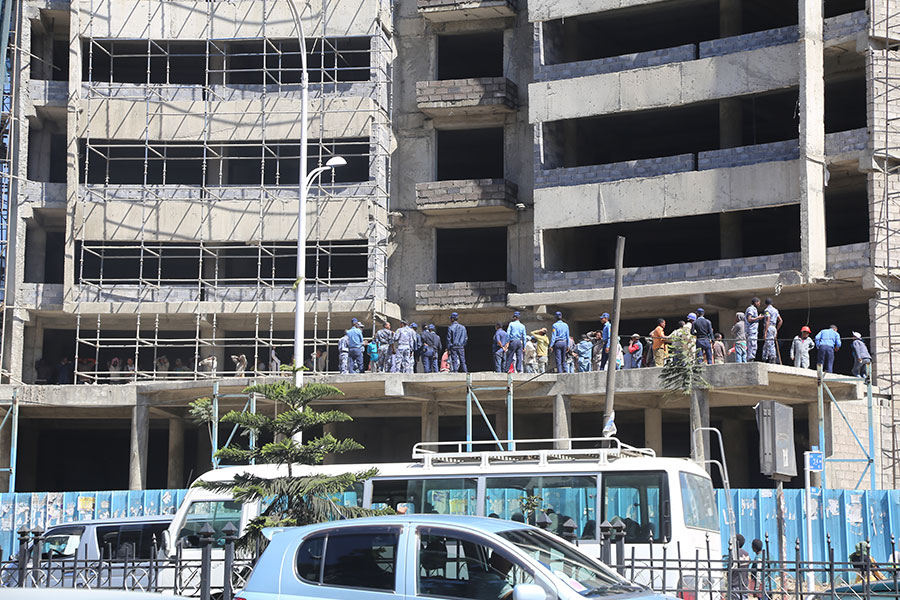
Radar | Sep 03,2022
May 4 , 2024
Large public projects exceeding 250 million Br will be required to use Building Information Modelling (BIM) software that integrates design, construction, logistics, operation, maintenance, budgets, and schedules, into one central platform. Spearheaded by the Construction Management Institute, the project is set to start next year. Officials believe it will modernise the construction sector and leverage digital tools to boost efficiency.
A widely adopted technology in developed countries, BIM is constantly updated as architects, engineers, and contractors contribute their expertise. The Institute of Ethiopian Standards is finalising national guidelines for its implementation, while the Ministry of Urban & Infrastructure is preparing complementary regulations.
Feleke Assefa, head of the technology transfer directorate at the Institute, pinpoints to lack of coordination as a major source of problems in construction projects, which leads to costly rework and demolitions. He believes BIM addresses this by allowing for the precise definition of information for every stage of the construction lifecycle, from design to maintenance.
"Everyone labours on their own now," Feleke told Fortune," which leads to cost overruns and delays in the projects."
Feleke hopes the increased automation will improve design approvals, follow-ups, and payment confirmations. He said the centralised data, accessible to contractors, consultants, and clients, helps with transparency and facilitates precise budgeting.
In anticipation of wider adoption, the Institute has been actively training and certifying professionals over the past year. The National Theatre on Gambia St, a diplomat housing development in the Cassanchis area, and several projects under the Oromia Construction Authority are already putting BIM to the test.
Projects require technology infrastructure. High-performance computers are needed to handle the 3D models, and project teams will need BIM-certified professionals to operate them. Studies highlight similar challenges in developing countries – investing in this technology and training a skilled workforce.
Familiar with the BIM tools, Mulugeta Begashaw, an architect who worked on several large construction projects, compares this adoption to the recent shift towards digital fuel payments. He acknowledges that initial confusion and hesitation are likely, but emphasises the long-term benefits for construction management, particularly in terms of transparency.
"The gains from transparency alone justify the change," he said.
Mulugeta stresses the importance of building professional competency in BIM tools to ensure smooth collaboration. While he anticipates structural and mechanical engineers to adapt quickly, he said "contractors might require additional incentives."
Ethiopia's construction industry has witnessed a slowdown in recent years, with growth averaging below five percent despite contributing a fifth to GDP. Soaring costs of primary construction inputs like cement and steel have exacerbated the troubles, fueled by the dip in credit from the banking industry to the above 20,000 registered contractors.
An anonymous grade three contractor acknowledges the importance of digitising project management. However, he expresses concern about its immediate impact given the lack of new projects.
"Low liquidity and few new projects are the main issues," he said.
BIM adoption reflects a global trend towards efficient construction practices. A study by Allied Market Research anticipates a nearly four-fold rise in the market size, reaching nearly 32 billion dollars worldwide within eight years.
However, Abebe Dinku (Prof), an academic and construction industry veteran, offers a cautious perspective. He said implementing BIM in Ethiopia's construction sector, which is currently characterised by a lack of transparency and information silos is necessary development.
"No contractor reveal their profits," he told Fortune.
For Abebe, extensive awareness campaigns and robust training programs should come first to bridge the knowledge gap. He cites an example of a consultant hesitant due to unfamiliar BIM costs and functionalities.
"Building a strong foundation is crucial," he said.
Despite Ethiopia's limited development of its construction industry, the expert indicated that most projects involve up to 20 subcontractors who usually work independently. Abebe says every professional involved can read up on what the other one is doing, even if they are located in different countries or continents.
"Even tax information can be obtained digitally," he said.
PUBLISHED ON
May 04,2024 [ VOL
25 , NO
1253]

Radar | Sep 03,2022

Fortune News | Aug 06,2022

Radar | Dec 25,2018

Radar | Sep 06,2020

Fortune News | Oct 19,2019

Radar | Dec 05,2020

Fortune News | Jun 23,2019

Fortune News | Sep 14,2024

Radar | Jan 19,2019

Featured | Oct 12,2019

Dec 22 , 2024 . By TIZITA SHEWAFERAW
Charged with transforming colossal state-owned enterprises into modern and competitiv...

Aug 18 , 2024 . By AKSAH ITALO
Although predictable Yonas Zerihun's job in the ride-hailing service is not immune to...

Jul 28 , 2024 . By TIZITA SHEWAFERAW
Unhabitual, perhaps too many, Samuel Gebreyohannes, 38, used to occasionally enjoy a couple of beers at breakfast. However, he recently swit...

Jul 13 , 2024 . By AKSAH ITALO
Investors who rely on tractors, trucks, and field vehicles for commuting, transporting commodities, and f...

Oct 18 , 2025
The political establishment, notably the ruling party and its top brass, has become p...

Oct 11 , 2025
Ladislas Farago, a roving Associated Press (AP) correspondent, arrived in Ethiopia in...

Oct 4 , 2025
Eyob Tekalegn (PhD) had been in the Governor's chair for only weeks when, on Septembe...

Sep 27 , 2025
Four years into an experiment with “shock therapy” in education, the national moo...